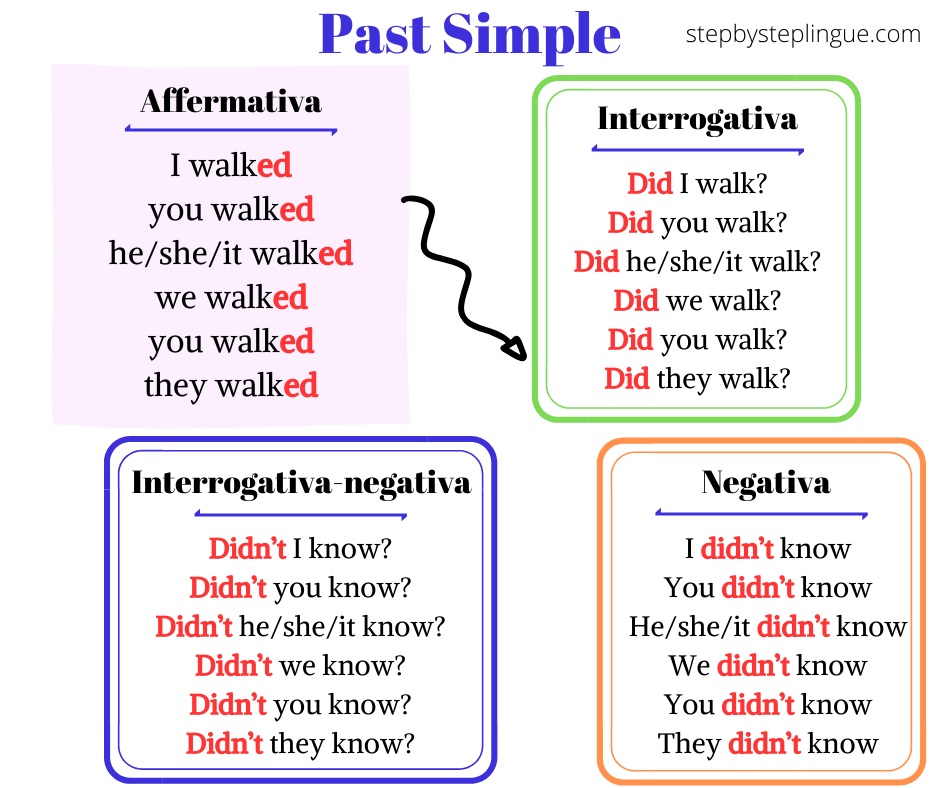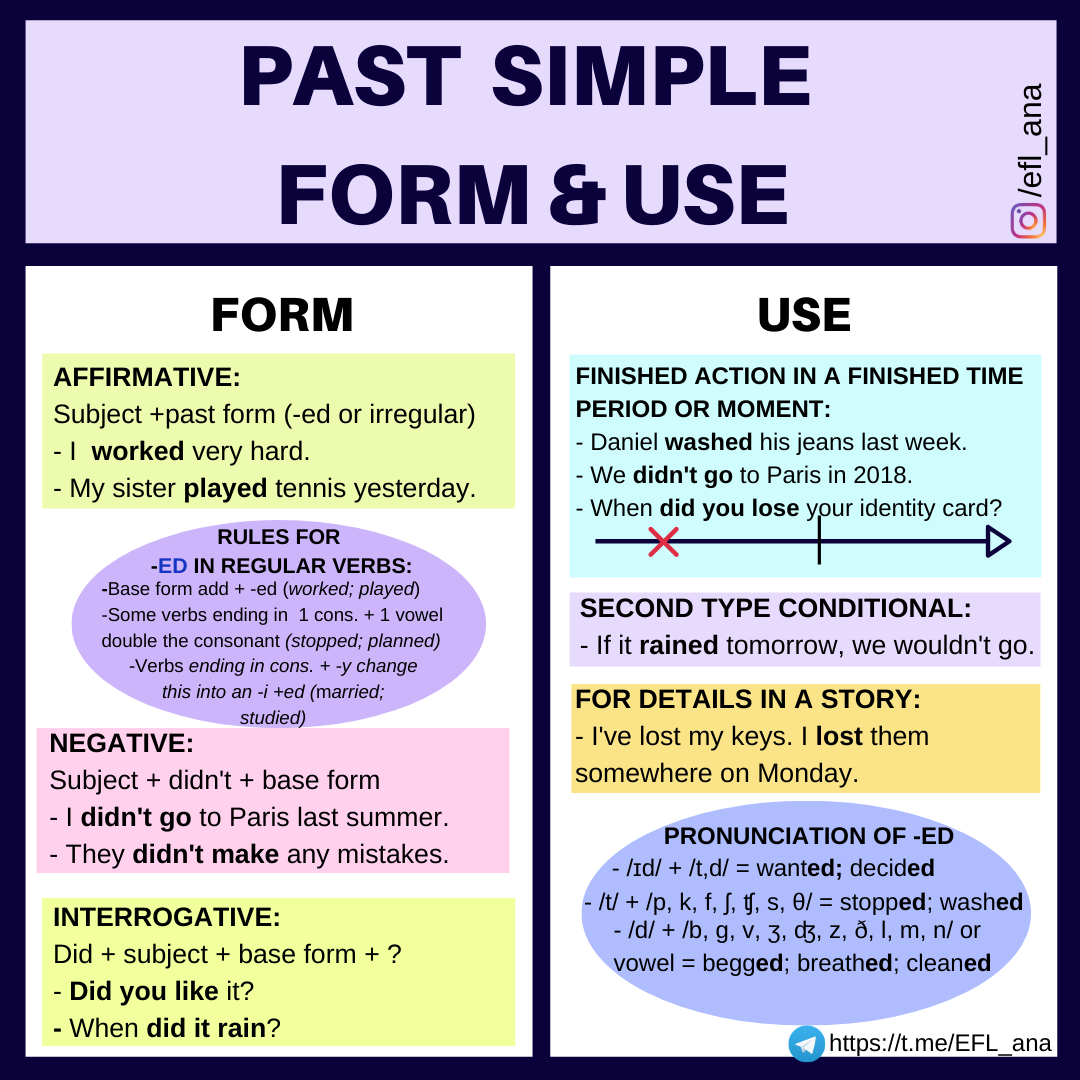
Esercizi to be / to have past simple
Verbs Past tense Past simple Past simple Level: beginner With most verbs, the past tense is formed by adding -ed: called liked wanted worked But there are a lot of irregular past tense forms in English. Here are the most common irregular verbs in English, with their past tense forms: We use the past tense to talk about:

Past Simple Past Continuous porównanie czasów Hello Rozmówki
You use Past Simple for situations which started and finished in the past. (finished time period) He taught English at primary school. /he doesn't teach English in primary school any more finished time period/ We lived in New York. /we don't live in New York any more finished time period/ I studied economics at university.

30+ Simple Past Did Background Sado
The simple past tense form is created by adding a -ed or -d affix to the root word of the verb. Some verbs use a -t variation where they end in a -t. For example, when "dream" turns into "dreamt." The past perfect tense is formed for regular verbs (ending in -ed, -d, or -t) by adding "had" followed by the verb. For example, "I had finished ."

Past Simple Forms
Revised on October 23, 2023. The simple past tense is a verb form used to refer to an action or series of actions that were completed in the past. The simple past tense of regular verbs is formed by adding "-ed" to the infinitive form of the verb (e.g., "cook" becomes "cooked"). Most verbs in the simple past take the same form.

Past Simple Examples
The past forms for irregular verbs are not regular -- you just have to learn them. Sometimes people study these verbs in groups based on the past simple form -- for example, 'buy', 'bring' and 'think' all have '-ought' in their past simple form: 'bought', 'brought' and 'thought'. All the best, Kirk The LearnEnglish Team

Spoil past simple simple past tense of spoil past participle v1 v2 v3
Past Simple Use of the Past Simple. The Past Simple is used to write and talk about completed actions that happened in a time before the present. It is the basic form of the past tense in English. Study the following information how to form the simple past and how to form the negation and questions. Regular Verbs. How to form: Infinitive + ed.

English Grammar The Past Simple/ Continuous Tense
Past simple - Form. Download full-size image from Pinterest Spelling of regular verbs. Download full-size image from Pinterest . Past simple - Use Completed actions in the past. We use the past simple to talk about actions or events that happened in the past. We know or we say when the events happened. I saw Jim yesterday. We didn't go.

Ćwiczenia Czas Przeszły Prosty Past Simple
The basic structure of the past simple is: Subject + past tense + object. So all you need to do is to put the verb in its past form. There are two types of verbs - regular and irregular. Regular verbs are easy because you simply have to add -ed, -d, or -ied. for verbs ending in most consonants, add -ed.

Past Simple Tense Review English Study Here
The past simple tense is used to talk about things that both started and ended in the past. It is one of the most commonly used tenses in English as it indicates something that has already happened. When to use the past simple tense To talk about events that happened in the past — I walked to school yesterday.

Paradiso delle mappe Be Past simple
The Past Simple (Simple Past) with Other Verbs. We make the past simple just like the present simple except we use 'did' instead of 'do / does'. It's really easy because 'did' doesn't change, even with 'he / she / it'. The positive: We usually make the positive by adding '-ed' to the infinitive. For example, 'play' becomes 'played'.

Easy English Grammar, English Grammar Worksheets, Grammar Lessons, Mind
Simple past inglese studied Past participle inglese studied Coniugazione del verbo "to study" Indicative Present I study you study he/she/it studies we study you study they study Present continuous I am studying you

CPI Tino Grandío Bilingual Sections Past simple tense
Correct answers: Past Simple Past Continuous Future Simple. Grammar Quizzes. Grammar Games. EnglishClub : Learn English : Grammar : Verbs : Tense : Tenses : Past Simple : Quiz. Online quiz to test your understanding of the Past Simple tense in English. This is a free multiple-choice quiz that you can do online or print out.

Verb use in past simple
Infinitive: to study Gerund: studying Past participle: studied Simple past: studied Irregular forms Auxilliary verb Spelling change Use contractions. Positive Negative. Indicative. Positive Negative. Present. I study I study: you study you study: he/she/it studies he/she/it studies: we study we study:

Past Simple FormPositive and Negative Simple past tense, English
To form the past simple of regular verbs we add the ending " -ed " to the verb. The form is the same for all persons (I, you, he, she, it, we, they). 1. For verbs that end in " e ", we only need to add " -d ": 2. If the verb ends in a short vowel plus a consonant (except " y " o " w "), we double the final consonant:

The Past Simple with "be" English Study Here
try - model verb ⓘ Verbs like 'try' change -y to -ie in the preterit, the past participle, and the 3rd person singular present indicative. Variants of the regular models: pass -s, -sh, -x, -o: +e

PAST SIMPLE AND PAST CONTINUOUS nttrungmtwiki
The simple past tense shows that you are talking about something that has already happened. Unlike the past continuous tense, which is used to talk about past events that happened over a period of time, the simple past tense indicates that the action occurred at a certain time and then was completed.